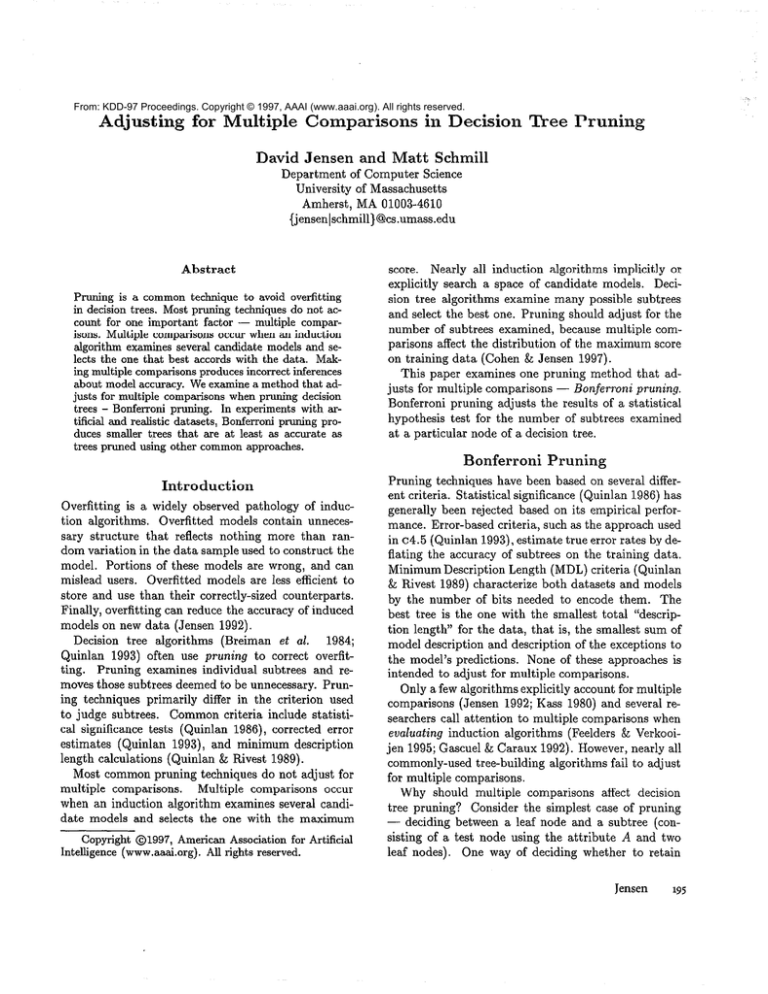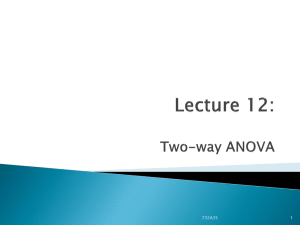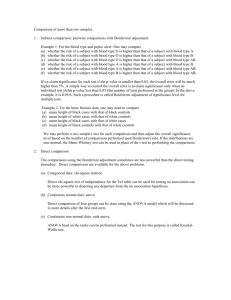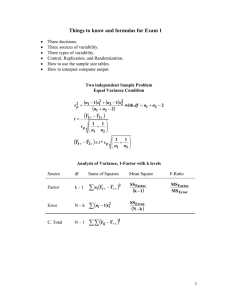
From: KDD-97 Proceedings. Copyright © 1997, AAAI (www.aaai.org). All rights reserved.
Adjusting
for Multiple
Comparisons
David
in Decision
Jensen and Matt
Tree Pruning
Schmill
Department of Computer Science
University of Massachusetts
Amherst, MA 01003-4610
{jensenIschmill}@cs.umass.edu
Abstract
Pruning is a common technique to avoid over-fitting
in decision trees. Most pruning techniques do not account for one important factor - multiple comparisons. Multiple comparisons occur when an induction
algorithm examines several candidate models and selects the one that best accords with the data. Making multiple comparisons produces incorrect inferences
about model accuracy. We examine a method that adjusts for multiple comparisons when pruning decision
trees - Bonferroni pruning. In experiments with ar-
tificial and r&i&ic
datasets.
nmninca mm--1---1- 1 Ronferroni
--------_r----r--
duces smaller trees that are at least as accurate as
trees pruned using other common approaches.
score. Nearly all induction algorithms implicitly or
explicitly search a space of candidate models. Decision tree algorithms examine many possible subtrees
and select the best one. Pruning should adjust for the
number of subtrees examined, because multiple comparisons affect the distribution of the maximum score
on training data (Cohen & Jensen 1997).
This paper examines one pruning method that adjusts for multiple comparisons - Bonferroni pruning.
Bonferroni pruning adjusts the results of a statistical
hypothesis test for the number of subtrees examined
at a particular node of a decision tree.
Bonferroni
Introduction
ent criteria.
Overfitting is a widely observed pathology of induction algorithms.
Overfitted models contain unnecessary structure that reflects nothing more than random variation in the data sample used to construct the
model. Portions of these models are wrong, and can
mislead users. Overfitted models are less efficient to
store and use than their correctly-sized counterparts.
Finally, overfitting can reduce the accuracy of induced
models on new data (Jensen 1992).
1’384;
Decision tree aigorithms (Breiman et ai.
Quinlan 1993) often use pruning to correct overfitting. Pruning examines individual subtrees and removes those subtrees deemed to be unnecessary. Pruning techniques primarily differ in the criterion used
to judge subtrees. Common criteria include statistical significance tests (Quinlan 1986), corrected error
estimates (Quinlan 1993), and minimum description
l--,rL
Itm~bu
-..I-.l-L:--GdlGUltLCI"llb
tn..:-I-\t&lllllarl
oCL
Pruning
Pruning techniques have been based on several differ-
n:---A
nAVesib
1non\
l.303,.
Most common pruning techniques do not adjust for
Multiple comparisons occur
multiple comparisons.
when an induction algorithm examines several candidate models and selects the one with the maximum
Copyright 01997, American Association for Artificial
- ...
Intellrgence (www.aa&orgj.
Ali rights reserved.
Statistical
significance
(Quinlan
1986) has
generally been rejected based on its empirical performance. Error-based criteria, such as the approach used
in ~4.5 (Quinlan 1993), estimate true error rates by deflating the accuracy of subtrees on the training data.
Minimum Description Length (MDL) criteria (Quinlan
& Rivest 1989) characterize both datasets and models
by the number of bits needed to encode them. The
best tree is the one with the smallest total “description
length”
for the data,
that
is, the smallest
sum of
model description and description of the exceptions to
the model’s predictions. None of these approaches is
intended
to adjust
for multiple
comparisons.
Only a few algorithms explicitly account for multiple
comparisons (Jensen 1992; Kass 1980) and several researchers call attention to multiple comparisons when
evaluating
induction
algorithms
(Feelders
& Verkooi-
jen 1995; Gascuel & Caraux 1992). However, nearly all
commonly-used tree-building algorithms fail to adjust
for multiple comparisons.
Why should multiple comparisons affect decision
tree pruning?
Consider the simplest case of pruning
- deciding between a leaf node and a subtree (consisting of a test node using the attribute A and two
ieaf nodesj . One way of deciding whether to retain
Jensen
195
the tree is to produce a score for the tree, denoted x.
The score could be the classification accuracy alone,
or some more complex function. For the tree to be
retained, x must exceed some threshold - either the
score for the leaf or some higher threshold. Call this
threshold the critical v&e, denoted xc.
One way of setting xc employs a statistical hypothesis test: xc is based on the reference distribution for
the score under the null hypothesis Ho that A is unrelated to the class variable. The score a: is an estimate
of some true score xt. Because x is based on a single
sample, it will vary somewhat from the true value. Because of this, there is some probability that x 2 x, even
though xt < xc. Hypothesis tests determine this probability under the null hypothesis Ho. The probability
that z will exceed x, given that the null hypothesis p(x 2 x,lHo) - is commonly denoted a. The value of
xe is usually set such that a is fairly small (e.g., 10%).
This approach, and nearly every ad hoc approach to
setting xc, ignores an important aspect of how decision
trees are built: the variable A was selected from a pool
of potential variables. Each variables’ scores had an
opportunity to exceed x,. If the potential variables
are independently distributed, then (Y # 0.10. Instead:
at = 1 - (1 - cXi)k
(1)
where at is the probability that at least one of the
k variables’ scores will equal or exceed x,, and CV;is
the probability that a pcsrticular variable’s score will
equai or exceed xc. If ffi is O.iO and 30 variables are
examined, then at = 0.96. Rather than a 10% probability of incorrectly selecting the tree, such selection
becomes nearly certain. In practice, induction algorithms evaluate dozens or even hundreds of variables
when selecting a variable for a test node. As a result,
adjusting for multiple comparisons becomes essential
for an accurate pruning. Multiple comparisons affect
L---d prulllrlg
--.--!-L^all11 Ll--~-l--lJ
bnresnolu-uaseu
wxhniq-ues, rega“u,e:“s
------“--“I-=
whether they explicitly employ statistical tests.
Equation 1 is one of a class of Bonferroni equations
(Kotz & Johnson 1982), that can be used to adjust
for multiple comparisons. Specifically, we can set at
and solve Equation 1 for a;, so that, for a given and
. . ..-l.m.
I1U111"kx
,.C ,-.,.-..,.A,,,,
"I L"Luparla"llD
1, mn
A., all
,,,...,,A,.+,
app"ptJ"aK
,,:t:,,l
LA1ULcu
x.,1..,
YCUUCJ
can be selected based on a reference distribution for
a single comparison. The next two sections present
both experiments with artificial and realistic data to
evaluate the effect of this approach.
Experiments
with
Artificial
Data
This experiment applies a simple tree-building algorithm to an artificially-generated
data set. Data are
196
KDD-97
created by randomly generating instances with 30 uniformly, independently, and identically distributed binary attributes. A binary classification variable is created by duplicating the first attribute. The values of
the classification are systematically corrupted by complementing each value with a probability of 0.1, producing a theoretical upper bound of 90% on classification accuracy. The theoretically correct tree has three
nodes - a decision node and two leaf nodes.
1118
c..,,
L..:lrl:,?+
lllr;az-lJu~lulrl~
e.l,,x.:+h,
alej”I1uL111
.qn~n
UDGU
;,$,.v.,,t;r.n
IIII”IIIIcb”I”II
mca;m
Ejcuu
(QI:nlan 1993) to choose the best attribute for a particular decision node. A leaf node is created when
no partition can improve accuracy on the training set.
The class label of the leaf node is determined by the
majority class of the training instances present at that
IV’P y&
nr,,nm-l
,wrh
ffinr
no,,.Aa l-Lam
ALU"" CAIU
UllUU hnttnm-nn
U"U""IC1 Lay hv
VJ ~‘
UU~I nf
"L LVUL
techniques: 1) FISHERS - Fisher’s exact, test (Kotz &
Johnson 1982) with a! = 0.10, which does not adjust for
multiple comparisons; 2) ERROR-BASED - The technique used in ~4.5 (Quinlan 1993); 3) MDL - Minimum description length, using Utgoff’s formulation
(Utgoff 1995); and 4) BONFERRONI - Fisher’s exact
test with Q adjusted for the number of comparisons
using the Bonferroni adjustment.
Training set size N is varied from 5 to 250 by increments of 5 instances. For each value of N, 100 trials are
conducted. Each trial generates a training set, induces
a tree, prunes the tree with each technique, and measures accuracy of the pruned trees on a test set of 1000
freshly generated instances. Tlhe complexity of pruned
trees is determined by counting the total number of
nodes. Results are averaged over the 100 trials.
Results are shown in Figure 1. In general, BONFERRONI produces the least complex and most accurate
trees. When N < 20, no technique reliably produces
the correct tree. BONFERRONI is the most conservative, producing less complex and less accurate trees
than other pruning techniques. For 20 < N < 30, accuracy of all pruned trees is roughly the same, and the
average accuracy of UNPRUNED trees is much lower.
For N > 40, BONFERRONI achieves nearly maximum
average accuracy, while other techniques have lower
average accuracy. This lower accuracy is due entirely
to overfitting.
Recall that all pruning methods begin with the same trees. Because, BONFERRONI produces pruned trees with nearly optimal accuracy, it is
clear that the true structure is present in the original
trees. For UNPRUNED, FISHERS, and MDL, complexity
is strongly associated with training set size. A related
paper (Oates & Jensen 1997) explores this behavior for
a wide variety of realistic datasets and several pruning
approaches.
4
r...
._
Ill
I
_ Cm-
“-“B
I
p
.~.
bonferroni w
T
.-.
7
fisher’s
unpruned
PP
0.50
’
70
.’.“.’“... “’ ..
60 I
50
.$
3
E
0
40
30
20
10
0
0
50
100
150
200
250
Number of instances
Figure 1: Accuracy
generated Data
TBA:
and Complexity
Tree-building
with
Adjustment
for Artificially-
Bonferroni
These experiments evaluate the performance of a new
algorithm - Tree-building with Bonferroni Adjustment (TBA) - on 13 UC1 datasets. TBA differs from
other aigorithms for top-down induction of decision
trees (Quinlan 1986) in three important ways: its evaluation function, how it selects partitions during tree
construction, and how it selects subtrees during tree
pruning.
TBA uses the G statistic to evaluate contingency
tables during tree construction and pruning. The G
statistic is used because it has a known reference dis, .1
tribution and because it is additive, aliowing portions
of contingency tables to be evaluated individually.
During tree construction, TBA selects attributes using an approach suggested by Kass (Kass 1980) and
Kerber (Kerber 1992). For each attribute, a contingency table is constructed with a row for each class
value and a column for each of a attribute vaiues every possible value for discrete attributes or every
unique interval for discretized continuous attributes.
Then, the pair of columns in the table with the least
significant difference is merged. The merging process
is repeated until all columns are significantly different. For continuous attributes, only adjacent columns,
corresponding to adjacent numeric intervals, can be
merged. The result is a node that partitions the sample into b subsamples, where 1 2 b 5 a.
TBA selects attributes based on their probability values. These values are calculated by comparing the
G value for the merged contingency table to an appropriate reference distribution, and applying a Bonferroni adjustment.
For a table with r rows and c
columns, the appropriate reference distribution is chisquare with (r- l)(c- 1) degrees of freedom. Following
Kass, the Bonferroni exponent k is the number of possible ways of combining a initial categories into b final
categories. TBA forms a decision node using the attribute with the lowest probability value, regardless of
whether that value exceeds some threshold Q. The algorithm uses the decision node to partition the sample
into b subsamples based on the attribute’s values, and
repeats the attribute selection process for each subsampie. Tree growth stops when no partition can improve
accuracy on the training set.
TBA prunes the tree by examining the probability values calculated during tree construction. Recall
that those probability values were adjusted for multiple
comparisons within an attribute, but were not adjusted
for multiple comparisons among the many attributes
that could be used at an individual node. The latter
adjustment is made at this stage, where the Bonferroni
exponent k is the number of attributes considered at
that node.
TBA examines each frontier node of the tree - decision nodes that have only leaf nodes as children. Frontier nodes where p 5 ot are retained; frontier nodes
where p > at are converted to leaf nodes and labeled
with the majority class of the appropriate training subsample. The process continues until all frontier nodes
are significant. For all results reported here, TBA was
run with at = 0.10.
Table 1 shows the results of applying TBA, ~4.5, and
TnA-lesion (a version of TBA without Bonferroni adjustment) to thirteen UC1 datasets. The experiments
used ten-foid cross-validation with the folds heldconstant across the runs of all three algorithms.
Italicized values are significantly different from the results
of TBA. Bold values are significantly different from the
results for TBA and are inconsistent with the hypothesis that TBA produces smaller trees that are at least
as accurate as those of C4.5. Significance was judged
using a two-tailed, paired t-test with crt = 0.10 and
a Bonferroni correction to adjust for 13 independent
Jensen
197
‘able 1: Cc lparison of 1 IA with c4.5
c4.5
TBA
size error
Dataset size error
breast
7 0.280
2:
2::
Cleveland
8 0.254
22 0.167
50 0.154
cl-x
14 0.342
0.289
glass
4": 0.248
heart
11 0.244
0.212
16
hepatitis
7 0.161
11 0.008
12 0.020
hypothyr
9 0.067
iris
4 0.047
d6 0.211
4 0.261
lymph
20 0.267 1.23 0.285
pima
votes
6 0.046
14 0.055
10 0.085
14 0.068
wine
20 0.052
14 0.060
Wisconsin
rd TBA-leSi0
TBA-lesion
size error
33 0.300
23 0.236
ii0
0.196
32 0.297
71 0.274
24 0.175
57 0.022
8 0.060
20 0.243
209 0.327
&7 0.062
21 0.057
52 0.082
comparisons. This adjusts for comparisons within each
column of the table, but not between columns. Thus,
for each of the columns in the table, there is a 10%
probability of incorrectly rejecting the null hypothesis
for at least one of the datasets.
In nearly all cases, the results are consistent with
the conjecture that TBA produces smaller trees than
~4.5 without sacrificing accuracy. In nine of the thirteen datasets, TBA produced significantly smaller trees,
in some cases dramatically smaller. TBA'S trees are
half the size, on average, of trees built by ~4.5. In
only one case was TBA’s accuracy significantly lower
than ~4.5’s. This dataset, hypothyroid,
is the only
set of the thirteen with substantial numbers of missing values. TBA uses a simple, but potentially inferior
method of handling missing values. In all cases, TBAlesion produces trees that are significantly larger, but
not significantly more accurate, than trees produced
by TBA.
Acknowledgments
The authors would like to thank Paul Cohen, Tim
Oates, Paul Utgoff, and two anonymous reviewers for
their comments on earlier versions of this paper. M.
Zwitter and M. Soklic of the University Medical Centre, Institute of Oncology, Ljubljana, Yugoslavia provided the breast and lymphography datasets, and Dr.
William H. Wolberg of the University of Wisconsin
Hospitals provided the Wisconsin dataset. This research is supported by DARPA/Rome Laboratory unrlpr
No
Thp
c chrprnUUL rnntrlrt
““~~“~~“”
A.“. wmcn3-a2-fun7c
l”“““Y
“V v ““I”.
. ..LSbTT
V.&J.
U”.“II~
ment is authorized to reproduce and distribute reprints
for governmental purposes notwithstanding any copyright notation hereon. The views and conclusions contained herein are those of the authors and should not
be interpreted as necessarily representing the official
policies or endorsements either expressed or implied,
198
KDD-97
of the Defense Advanced Research Projects Agency,
Rome Laboratory or the U.S. Government.
References
Breiman, L.; Friedman, J.; Olshen, R.; and Stone, C.
1984. Classification and Regression Trees. Wadsworth
and Brooks.
Cohen, P., and Jensen, D. 1997. Overfitting explained. In Preliminary Papers of the Sixth Innternational Workshop on Artificial Intelligence and Statistics.
Feelders, A., and Verkooijen, W. 1995. Which method
learns the most from data? methodological issues in
the analysis of comparative studies. In Preliminary
Papers of the Fifth International
Workshop on Artificial Intelligence and Statistics.
Gascuel, O., and Caraux, G. 1992. Statistical significance in inductive learning. In ECAI92: Proceedings
of the 10th European Conference on Artificial Intelligence, 435-439.
Jensen, D. 1992. Induction with Randomization Testing: Decision-Oriented Analysis of Large Data Sets.
Ph.D. Dissertation, Washington University, St. Louis
Missouri.
Kass, G. 1980. An exploratory technique for investigating large quantities of categorical data. Applied
Statistics 291199-127.
Kerber, R. 1992. Chimerge: Discretization of numeric
attributes. In Proceedings of the Tenth National Conference on Artificial Intelligence, 123-128.
Kotz, S., and Johnson, N., eds. 1982. Encyclopedia
of Statistical Sciences. Wiley.
Oates, T., and Jensen, D. 1997. The effects of training
set size on decision tree complexity. In To appear in
the Proceedings of the Fourteenth International Conference on Machine Learning.
Quinlan, J., and Rive&, R. 1989. Inferring decision
trees using the minimum description length principle.
Information and Computation 80:227-248.
Quinlan, J. 1986. Induction of decision trees. Machine
Learning 1:81-106.
Quinlan, J. 1993. C4.5: Programs for Machine Learning. Morgan Kaufmann Publishers.
Utgoff, P. 1995. Decision tree induction based on
efficient tree restructuring.
Technical Report 95-18,
Department of Computer Science, University of Massachusetts, Amherst.





